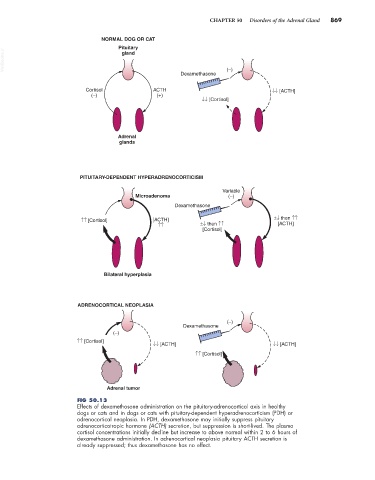Page 897 - Small Animal Internal Medicine, 6th Edition
P. 897
CHAPTER 50 Disorders of the Adrenal Gland 869
NORMAL DOG OR CAT
Pituitary
VetBooks.ir
gland
Dexamethasone (–)
Cortisol ACTH ↓↓ [ACTH]
(–) (+)
↓↓ [Cortisol]
Adrenal
glands
PITUITARY-DEPENDENT HYPERADRENOCORTICISM
Variable
Microadenoma (–)
Dexamethasone
↑↑ [Cortisol] [ACTH] ±↓ then ↑↑
↑↑ ±↓ then ↑↑ [ACTH]
[Cortisol]
Bilateral hyperplasia
ADRENOCORTICAL NEOPLASIA
(–)
Dexamethasone
(–)
↑↑ [Cortisol]
↓↓ [ACTH] ↓↓ [ACTH]
↑↑ [Cortisol]
Adrenal tumor
FIG 50.13
Effects of dexamethasone administration on the pituitary-adrenocortical axis in healthy
dogs or cats and in dogs or cats with pituitary-dependent hyperadrenocorticism (PDH) or
adrenocortical neoplasia. In PDH, dexamethasone may initially suppress pituitary
adrenocorticotropic hormone (ACTH) secretion, but suppression is short-lived. The plasma
cortisol concentrations initially decline but increase to above normal within 2 to 6 hours of
dexamethasone administration. In adrenocortical neoplasia pituitary ACTH secretion is
already suppressed; thus dexamethasone has no effect.

